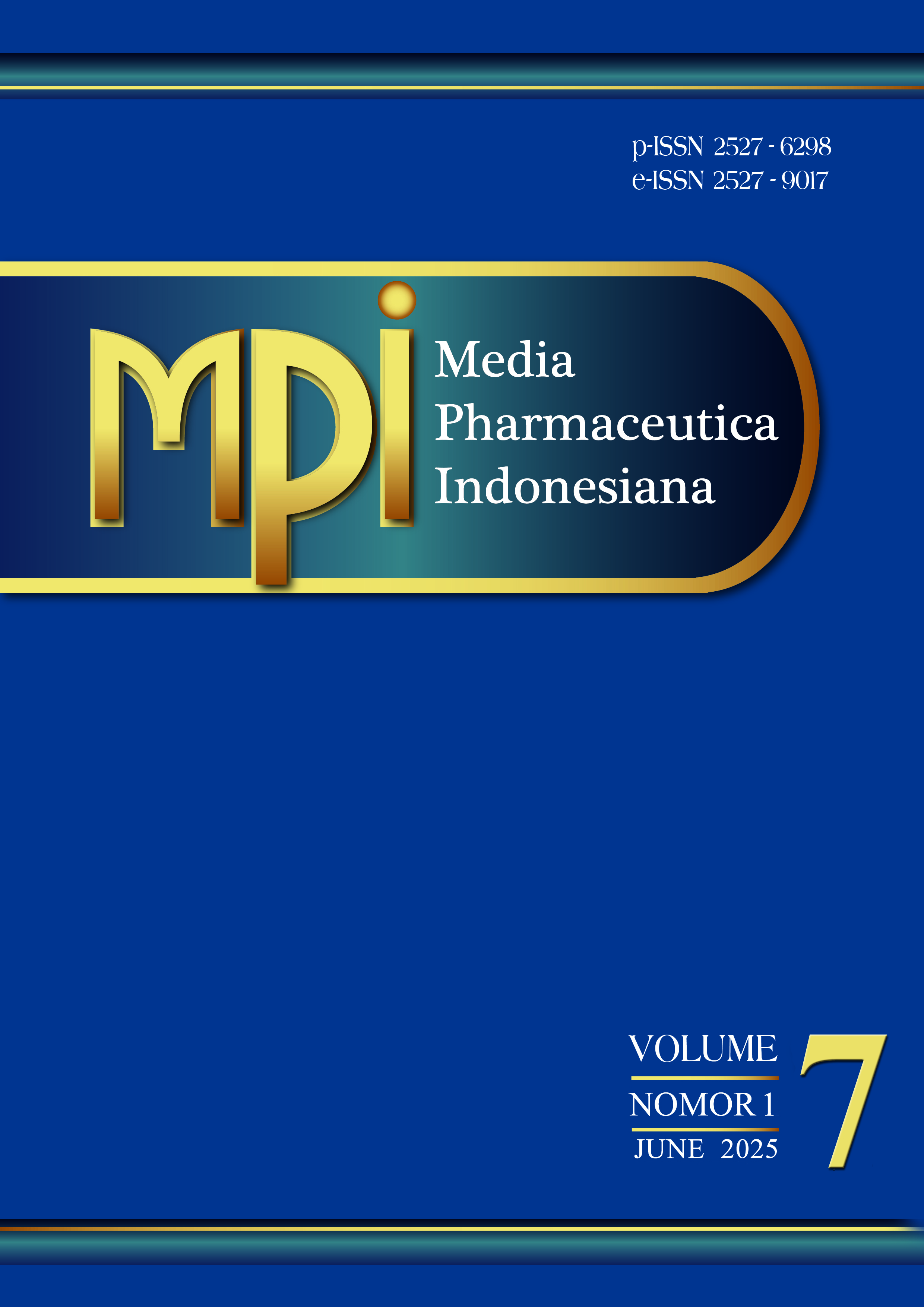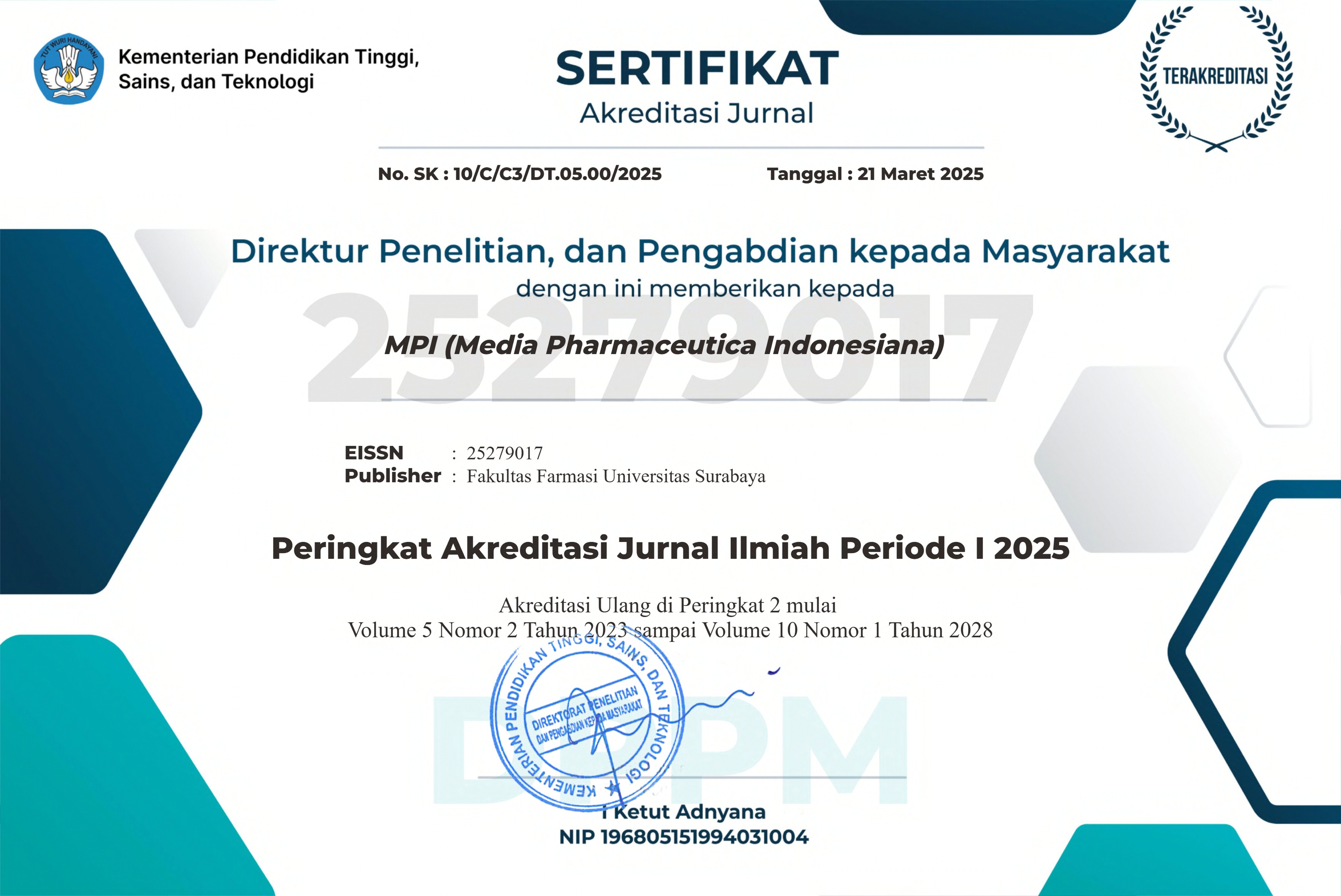Formulasi dan Uji Aktivitas Antibakteri Serum Antijerawat yang Mengandung Minyak Atsiri Bunga Lawang (Illicium verum Hook. f.)
 Abstract Views:
477 times
Abstract Views:
477 times
 PDF Downloads:
458 times
PDF Downloads:
458 times
Abstract
Acne vulgaris merupakan peradangan unit polisebasea yang sering dikaitkan dengan infeksi Cutibacterium acnes (C. acnes). Penggunaan antibakteri topikal seperti klindamisin secara berlebihan telah menyebabkan resistensi C. acnes, sehingga diperlukan alternatif pengobatan. Minyak atsiri bunga lawang (Illicium verumHook. f.) mengandung trans-anetol yang diketahui memiliki aktivitas antibakteri, namun belum banyak diteliti terhadap C. acnes. Penelitian ini bertujuan untuk mengevaluasi aktivitas antibakteri minyak atsiri bunga lawang terhadap C. acnes, menentukan nilai Minimum Inhibitory Concentration (MIC) dan Minimum Bactericidal Concentration (MBC), serta mengembangkan formula serum topikal yang optimal dan efektivitas antibakteri serum minyak atsiri bunga lawang. Metode yang digunakan meliputi uji difusi agar dan makrodilusi. Kontrol positif berupa gel 1% klindamisin, sedangkan kontrol negatif menggunakan DMSO 100% dan formula tanpa minyak atsiri. Minyak atsiri konsentrasi 100% menunjukkan zona hambat terbesar 12,875 ± 0,609 mm. MIC tercatat sebesar 1,56%, sedangkan MBC >25%. Formula serum terbaik adalah F2 yang mengandung 5% minyak atsiri, dengan hasil evaluasi mutu organoleptis berupa cair agak kental berwarna putih dengan aroma khas bunga lawang, homogen, pH 4,947, tipe emulsi m/a, belum memenuhi syarat untuk viskositas dan daya sebar serta mempunyai zona hambat 7,558 ± 0,319 mm. Hasil ini menunjukkan potensi minyak atsiri sebagai antibakteri alternatif dalam pengobatan jerawat.
Acne vulgaris is an inflammatory condition of the pilosebaceous unit frequently associated with Cutibacterium acnes (C. acnes) infection. Excessive use of topical antibiotics such as clindamycin has led to the emergence of resistant C. acnes strains, necessitating alternative therapeutic approaches. Illicium verum essential oil, known for its high trans-anethole content, possesses antibacterial properties, though its efficacy against C. acnes remains underexplored. This study aims to evaluate the antibacterial activity of I. verum essential oil against C. acnes, determine its Minimum Inhibitory Concentration (MIC) and Minimum Bactericidal Concentration (MBC), and develop an optimized topical serum formulation. Antibacterial activity was assessed using agar diffusion and macro-dilution methods. A 1% clindamycin gel served as the positive control, while 100% DMSO and a base formulation without essential oil were used as negative controls. The 100% essential oil exhibited the largest inhibition zone (12.875 ± 0.609 mm), with an MIC of 1.56% and MBC >25%. The optimal serum formulation (F2) contained 5% essential oil and showed desirable organoleptic properties, pH 4.947, oil-in-water emulsion type, though it did not meet the criteria for viscosity and spreadability. Its antibacterial zone was 7.558 ± 0.319 mm. These findings indicate the potential of I. verum essential oil as an alternative antibacterial agent for acne treatment.
Submitted: 16-08-2024, Revised: 16-12-2024, Accepted: 21-04-2025, Published regularly: June 2025
Downloads

This work is licensed under a Creative Commons Attribution-ShareAlike 4.0 International License.
Articles published in MPI are licensed under a Creative Commons Attribution-ShareAlike 4.0 International (CC BY-SA) license. You are free to copy, transform, or redistribute articles for any lawful purpose in any medium, provided you give appropriate credit to the original author(s) and MPI, link to the license, indicate if changes were made, and redistribute any derivative work under the same license.
Copyright on articles is retained by the respective author(s), without restrictions. A non-exclusive license is granted to MPI to publish the article and identify itself as its original publisher, along with the commercial right to include the article in a hardcopy issue for sale to libraries and individuals.
By publishing in MPI, authors grant any third party the right to use their article to the extent provided by the CC BY-SA license.

 DOI:
DOI:










